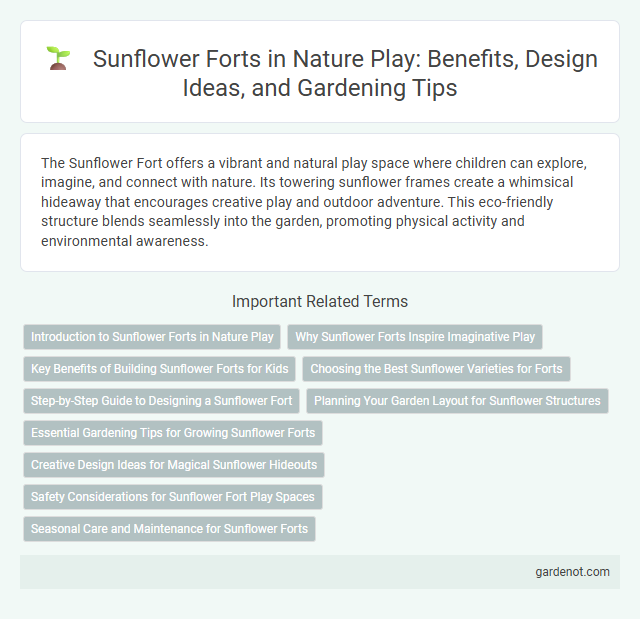The Sunflower Fort offers a vibrant and natural play space where children can explore, imagine, and connect with nature. Its towering sunflower frames create a whimsical hideaway that encourages creative play and outdoor adventure. This eco-friendly structure blends seamlessly into the garden, promoting physical activity and environmental awareness.
Introduction to Sunflower Forts in Nature Play
Sunflower Forts in nature play environments encourage creativity and outdoor exploration by providing natural, sustainable structures made from sunflowers and other plant materials. These forts promote sensory engagement and foster imaginative play, enhancing children's connection with the environment. Integrating Sunflower Forts into play areas supports biodiversity and environmental education through hands-on interaction with living plants.
Why Sunflower Forts Inspire Imaginative Play
Sunflower Forts inspire imaginative play by providing a natural setting that encourages creativity and sensory exploration through vibrant colors, unique textures, and dynamic shapes. These forts serve as versatile spaces where children can engage in role-playing, storytelling, and collaborative adventures, fostering cognitive and social development. The integration of natural elements like sunflowers and wooden structures promotes environmental awareness while stimulating curiosity and problem-solving skills.
Key Benefits of Building Sunflower Forts for Kids
Building sunflower forts enhances children's creativity and problem-solving skills by encouraging imaginative play and hands-on construction. The natural materials used in creating these forts promote a deeper connection with the environment and foster sensory development. Engaging in sunflower fort activities also supports physical activity, teamwork, and social interaction among kids.
Choosing the Best Sunflower Varieties for Forts
Selecting the best sunflower varieties for forts involves prioritizing tall, sturdy plants like Giant Russian and Mammoth sunflowers, which provide natural walls and privacy. Varieties with strong stems support climbing and weaving, essential for creating durable, interactive structures in nature play. Choosing fast-growing types ensures a rapid transformation of the play area into an engaging sunflower fort.
Step-by-Step Guide to Designing a Sunflower Fort
Designing a sunflower fort begins with selecting a sunny location and preparing fertile soil enriched with organic compost to support healthy sunflower growth. Next, arrange sunflower seeds in a circular pattern with sufficient spacing, approximately 12 inches apart, to allow tall, sturdy stalks that naturally form a protective wall. Regular watering and mulching maintain soil moisture, while strategic pruning encourages strong stems, ensuring the sunflower fort achieves both stability and a vibrant, inviting play space.
Planning Your Garden Layout for Sunflower Structures
Designing a sunflower fort requires careful planning of your garden layout to maximize sunlight exposure and ensure healthy growth. Sunflowers thrive in well-drained soil with ample space, so position the structure where it receives at least six hours of direct sunlight daily. Incorporate companion plants around the fort to enhance soil nutrients and create a vibrant, sustainable play area.
Essential Gardening Tips for Growing Sunflower Forts
For successful growth of Sunflower Forts, choose well-drained soil rich in organic matter and ensure full sun exposure of at least 6-8 hours daily. Maintain consistent moisture by watering deeply but avoid waterlogging to prevent root rot. Support tall stems with stakes or nearby structures to withstand wind and promote healthy, robust flower development.
Creative Design Ideas for Magical Sunflower Hideouts
Sunflower forts transform outdoor spaces into enchanting nature play areas, inviting children to explore imaginative hideouts surrounded by vibrant yellow blooms. Integrating natural materials like wooden planks and woven vines enhances the sensory experience, while incorporating cozy nooks and small entryways encourages creative role-play and storytelling. Utilizing varied sunflower heights and colors adds depth and texture, making each hideout a unique, magical retreat that fosters a deep connection with the natural environment.
Safety Considerations for Sunflower Fort Play Spaces
Sunflower Fort play spaces incorporate safety measures such as rounded edges, non-toxic materials, and secure anchoring to prevent injuries. The design emphasizes visibility for caregivers, ensuring children remain within sight during play. Environmental factors like sun exposure and weather resistance are addressed through shaded areas and durable construction materials.
Seasonal Care and Maintenance for Sunflower Forts
Seasonal care and maintenance for Sunflower Forts involve regular inspection of wooden structures for rot, insect damage, and weathering, especially after winter and rainy seasons. Applying eco-friendly sealants and treating sunflowers with natural fertilizers enhances durability and promotes healthy growth throughout the year. Removing dead plant matter and pruning sunflowers in late autumn ensures the fort remains safe and visually appealing for future use.
Sunflower fort Infographic

 gardenot.com
gardenot.com